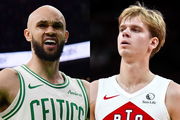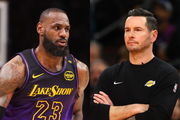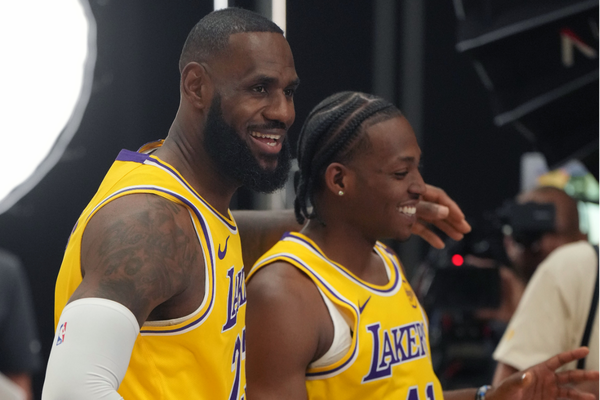

“I just want a job in the NBA. I honestly don’t know what’s next.” Lakers rookie Quincy Olivari certainly stood out as one of the major highlights during the preseason. His 11-point performance against the Milwaukee Bucks was memorable enough to earn him praise from both JJ Redick and LeBron James, while the 22 points he scored against the Golden State Warriors showed just what he could offer to the team. Despite all this, his presence during the regular season was still under a cloud of doubt, as the player was playing under an Exhibition 10 contract. Fortunately, the Lakers chose to place their faith in the 23-year-old, and have now awarded him with a two-way contract.
Watch What’s Trending Now!
While it does not provide the same level of guarantee as a proper rookie-scale contract, it will still allow the player to be a part of the franchise for the foreseeable future. Therefore, without any further ado, let us know more about the type of contract that Quincy Olivari, and a couple of other players, recently placed their ink on.
ADVERTISEMENT
What is a Two-Way Contract?
First established during the 2017-18 NBA season, players signed under the Two-Way Contract get to split their time between their respective NBA teams and the G-League affiliate of the same franchise. Accordingly, the players are paid based on which league they play for. The concept allows teams to not only have more players at their disposal but also have their choice of pick on which squad member they would like to promote/demote to the main lineup.
As for the aspiring players themselves, it gives them a golden chance to be a part of the NBA if they go undrafted, such as was the case with Quincy Olivari. After all, Two-Way Contracts allow teams to keep the players reportedly ‘on retainer’ without signing them to a full-time contract that would cost the franchise more.
Top Stories
Did NBA Fine Derrick White and Grady Dick for Exchanging Jerseys? Fact Checking Viral News

Did Zion Williamson Slide Into Sydney Sweeney’s DMs? Fact Checking the Viral Screenshot

Luka Doncic Injury Update: Latest on the Lakers Star and Expected Return Timeline

LeBron James & JJ Redick Helpless As NBA Ignores Lakers Plea Despite 5 Punishments

Cameron Brink Announces Personal Decision Ahead of Unrivaled Debut With Paige Bueckers

From the 2022 season onwards, teams were allowed to give out 2 Two-Way Contracts per season. The same number was increased to 3 during the previous season. The concept of the contract has been created to accommodate the earlier makeup of the teams too. This means that the 3 players would be taken in addition to the 15 players who are already there under standard contracts.
ADVERTISEMENT

Imago
Sep 30, 2024; El Segundo, CA, USA; Los Angeles Lakers foward LeBron James (23) with guard Quincy Olivari (41) during media day at the UCLA Health Training Center. Mandatory Credit: Kirby Lee-Imagn Images
Two-way contracts also provide an additional benefit to the teams, as players can be taken in without the cost of further adding on to the salary cap. Given how so many franchises have been struggling to stay below the luxury tax and apron limits set under the updated CBA guidelines, signing athletes under two-way provides a welcome relief.
ADVERTISEMENT
However, being eligible for a two-way contract has its own list of criteria. The concept has been created to favor the younger and inexperienced players, as only those who have less than four years of experience in the league can sign the contracts. It is important to note that you can only play 3-4 games in a season, and it would still be counted as a full season.
What is the Salary Difference between a rookie player under a regular NBA Contract and a Two-Way Contract?
The difference in salary between rookie players depends on when they’re picked during the draft, with the No. 1 pick usually earning the most, and the No. 60 pick less than him. Despite this, all of them would usually earn more than the minimum rookie salary limit by the NBA. The same, unfortunately, cannot be said for those under two-way contracts who earn HALF of the minimum limit. Since the rookie minimum for the 2023-24 season was $1.1 million, the two-way salary limit was $559,782. Furthermore, two-way players are ineligible to receive any performance bonuses.
ADVERTISEMENT
Two-way contracts are usually reserved for second-round draft picks as well as undrafted and Exhibition 10 players since they would anyway earn less than the first-round picks. However, not all second-round draft picks are handed two-way contracts, with the decision to do so lying upon the franchises.
For example, Bronny James, son of Los Angeles Lakers legend LeBron James, was taken in as the 55 overall pick under a 4-year $7.89 million contract, with almost $4.4 million of it being placed under the guaranteed category. However, the 55 pick during the 2023 NBA Draft, Isaiah Wong, was signed under a 2-way contract worth only $559,782.
ADVERTISEMENT
Do Players under Two-Way Contracts face any restrictions?
The low pay is not the only thing that differentiates a regular rookie player and one under a two-way contract. Players representing the league through this concept are required to spend a significant portion in the G-League, meaning that they can’t play more than 50 regular season games in the NBA. On top of that, players under two-way contracts are also not allowed to be in the playoffs!
The restrictions have been fluctuating ever since the Two-Way Contract concept was introduced in the league. As reported by the Boston Sports Journal, changes in the NBA brought about in light of the COVID-19 pandemic caused two-way players to be eligible for the 2020 NBA Playoffs within the established bubble.
By the next season, the limit was increased from 45 to 50 games. However, in March 2021, the NBA’s Board of Governors and Commissioner Adam Silver green-lit a deal that would remove the 50-game cap, and even allow the players to participate in the playoffs! Unfortunately, the restriction was once again imposed from the following season onwards.
ADVERTISEMENT
Which players have been granted two-way contracts in the aftermath of the 2024-25 Preseason?
As highlighted above, Quincy Olivari is amongst those who will go on to be a prominent part of the upcoming regular season, thanks to the two-way contract from the Los Angeles Lakers. While the exact details of the player’s deal are not known, it has been revealed that the franchise waived second-year center Colin Castleton to make space for Olivari. Even details of Castleton’s 1-year, two-way contract were kept under wrap.
OFFICIAL: The Lakers have converted Quincy Olivari to a two-way contract pic.twitter.com/eYqwlh3imK
— Los Angeles Lakers (@Lakers) October 19, 2024
ADVERTISEMENT
While the Lakers made their change, the Memphis Grizzlies provided a two-way contract to Japanese point guard Yuki Kawamura. Similarly to Olivari, Kawamura is also 23 years old, went undrafted, and was taken in under an Exhibition 10 contract.
From a far-away glance, the Japanese star’s stats wouldn’t seem that impressive, since he only averaged 3.4 points, 0.2 rebounds, and 4.2 assists during the preseason. However, the 10 points he scored against the Indiana Pacers, combined with 7 assists, helped to elevate his status. From making an assist over the top of his opponents’ heads to Maozinha Pereira to then passing the ball to Zach Edey by shifting to the opposite direction at the last minute, Kawamura’s on-court prowess seemed more impressive than the stats. It earned him the love of fans, which later converted to a proper contract that would allow him to represent the NBA.
Additionally, the Chicago Bulls have now taken in EJ Liddell. The 23-year-old sent out his relief over receiving the two-way contract by taking to social media and writing, “Chi town I am grateful to be here! A kid from downstate Illinois gets a chance to represent his home state team.”
ADVERTISEMENT
Since the introduction of the concept, several players have been promoted from two-way to regular contracts, providing them with all the benefits and increased pay that comes with it. Whether Quincy Olivari and Yuki Kawamura can prove their worth well enough to follow in the same path as the players before them remains to be seen.
ADVERTISEMENT
ADVERTISEMENT
ADVERTISEMENT

